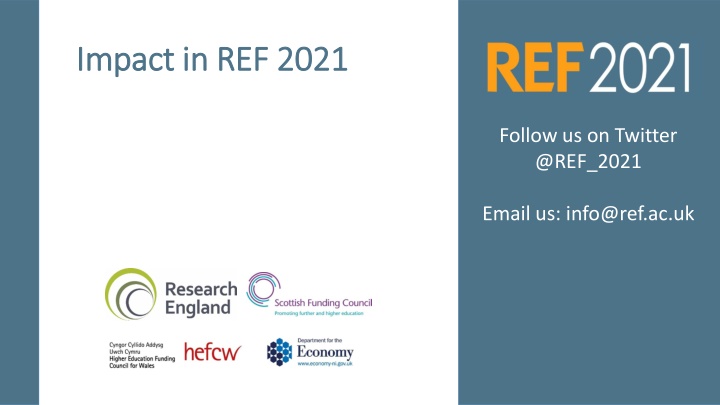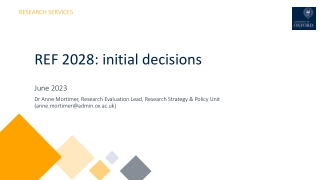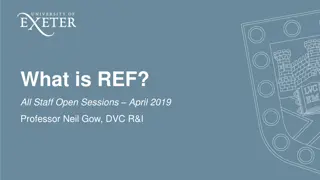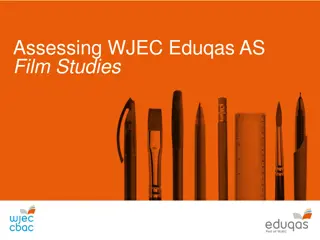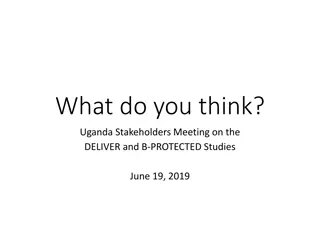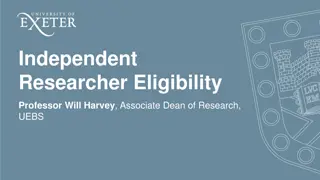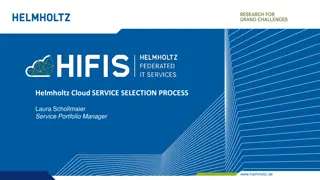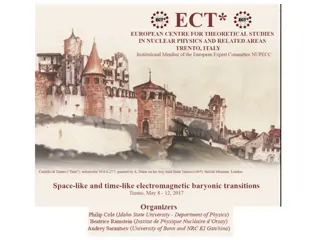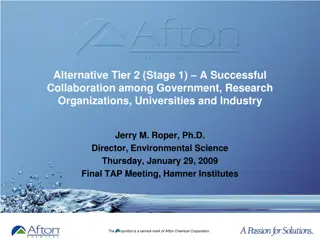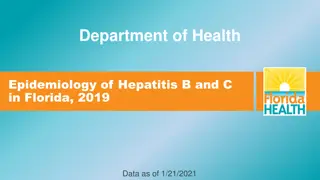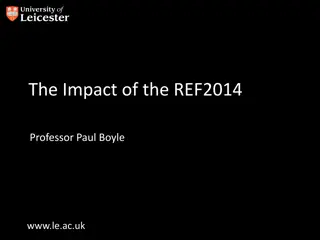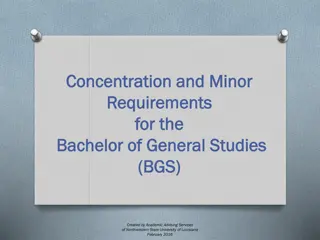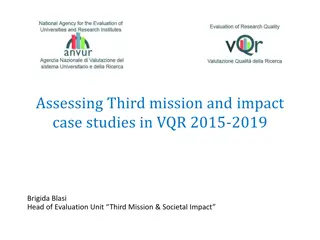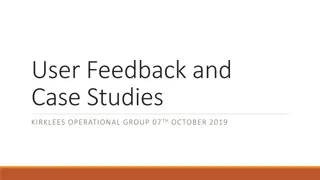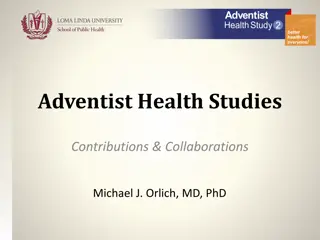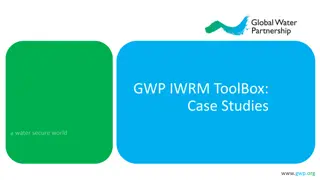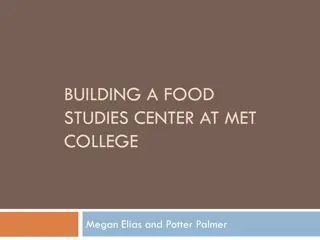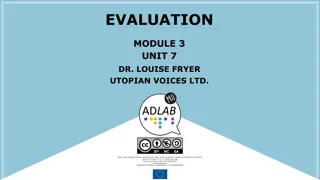Impact in REF 2021: Case Studies and Criteria
Impact of research in REF 2021 through case studies and criteria. Learn about the significance, reach, and eligibility factors that determine the impact on various aspects beyond academia. Submission requirements and underpinning research details are also provided.
Download Presentation

Please find below an Image/Link to download the presentation.
The content on the website is provided AS IS for your information and personal use only. It may not be sold, licensed, or shared on other websites without obtaining consent from the author.If you encounter any issues during the download, it is possible that the publisher has removed the file from their server.
You are allowed to download the files provided on this website for personal or commercial use, subject to the condition that they are used lawfully. All files are the property of their respective owners.
The content on the website is provided AS IS for your information and personal use only. It may not be sold, licensed, or shared on other websites without obtaining consent from the author.
E N D
Presentation Transcript
Impact in REF 2021 Impact in REF 2021 Follow us on Twitter @REF_2021 Email us: info@ref.ac.uk
Impact an effect on, change or benefit to the economy, society, culture, public policy or services, health, the environment or quality of life, beyond academia How many case studies were submitted to REF 2014? 6,975 6,975 What percentage of case studies were judged outstanding (4*)? 44% 44% How many countries were mentioned in case studies in 2014? 205 205
Impact criteria Reach Significance the extent and/or diversity of the beneficiaries of the impact, as relevant to the nature of the impact. (It will not be assessed in geographic terms, nor in terms of absolute numbers of beneficiaries.) the degree to which the impact has enabled, enriched, influenced, informed or changed the performance, policies, practices, products, services, understanding, awareness or well-being of the beneficiaries.
Impact - eligibility Each submission must include impact case studies that describe a specific impact: that meets the definition occurred during period 1 Aug 2013 to 31 Jul 2020 was underpinned by excellent research produced by the submitted unit. Number of case studies required relates to submitted FTE of unit All the material required to make a judgement should be included in the case study Don t need to be representative of activity across unit
Impact underpinning research To be eligible for assessment as an impact, the impact described in a case study must have been: Research made a distinct and material contribution Can be indirect or non-linear Threshold judgement underpinned by Research as a whole is at least equivalent to two star References and indicators to be included Threshold judgement excellent research produced by the submitting unit, 1 Jan 2000-31 Dec 2020 Staff carried out research within scope of UOA descriptor, while working in the submitting HEI Can include Cat C; doesn t include research students
Submission requirements Number of case studies determined by FTE of Category A staff submitted. Category A submitted staff (FTE) Required number of case studies Up to 19.99 2 20-34.99 3 35-49.99 4 50-64.99 5 65-79.99 6 80-94.99 7 95-109.99 8 110-159.99 9 160 or more 10, plus 1 further case study per additional 50 FTE
Consistency with 2014 Impact remains with institution where research was generated (i.e. not portable) Impact must be underpinned by excellent research of minimum 2* quality Timeframe: 1 January 2000 - 31 December 2020 for underpinning research 1 August 2013 - 31 July 2020 for impacts
Refinements for REF 2021 Weighting increased to 25% (60% for outputs and 15% for environment) Impact template to be included as explicit section in environment element Required routine provision of audit evidence will not be routinely provided to sub-panels Inclusion of additional contextual data in ICS template (e.g. funder info.) Guidelines for standardisation of quantitative data in ICS
Continued case studies a. the body of underpinning research is the same as described in a 2014 case study. This should not be understood solely in relation to the referenced outputs, but means that the continued case study does not describe any new research having taken place since the previous case study that has made a distinct and material contribution to the impact AND AND b. there is significant overlap in the impact described, so that the impact types and beneficiaries are broadly the same as described in the 2014 case study. Must flag continued case studies in the template Still need to meet REF 2021 eligibility criteria Panels set out their expectations in Panel criteria and working methods
Impact on teaching within the HEI Impact on teaching within own HEI is eligible Sub-panels expect that impact on teaching within the submitting unit s own institution may most convincingly form a component of a wider case study that also includes impacts beyond the institution. Some examples: Influencing the design and delivery of curriculum and syllabi in schools, HEIs or other educational institutions. Reduced gap in academic attainment for students with protected characteristics. Think about reach and significance
Public engagement Enhanced guidance on public engagement Sub-panels will welcome, and assess equitably, case studies describing impacts achieved through public engagement, either as the main impact described or as one facet of a wider range of impacts. Panels expect that case studies based on public engagement will demonstrate both reach (e.g. through audience or participant figures) and significance, and will take both into account when assessing the impacts. Examples in Annex A of Panel criteria and working methods
Research activity and bodies of work There are many ways excellent research may have underpinned impact including through bodies of work produced over a number of years, or the output(s) of a particular project conducted by one or more individuals, teams or groups. Recognising that the relationship between research and impact can be indirect and non-linear Provide up to six key references of underpinning research Not all have to meet the 2* threshold, but the work as a whole must
Case studies requiring security clearance Where research has had impacts of a sensitive nature and the case study can only be assessed by individuals with national security vetting clearance Must request advance permission from the REF Director Deadlines: 30 May 2019, 20 September 2019, 6 December 2019 Deadlines: 30 May 2019, 20 September 2019, 6 December 2019
What makes a strong case study? Panel overview reports from 2014: High-scoring Low-scoring Clear and compelling narrative Clearly identified beneficiaries Explicit links between research and claimed impact Self-contained Verifiable evidence of reach and significance Evidence of unit s contribution to research Distinguishes between dissemination and impact Lack of objective evidence Superficial impacts Vague description of impacts and/or their relationship to the research Focus on dissemination without explaining outcomes ( so what? )
